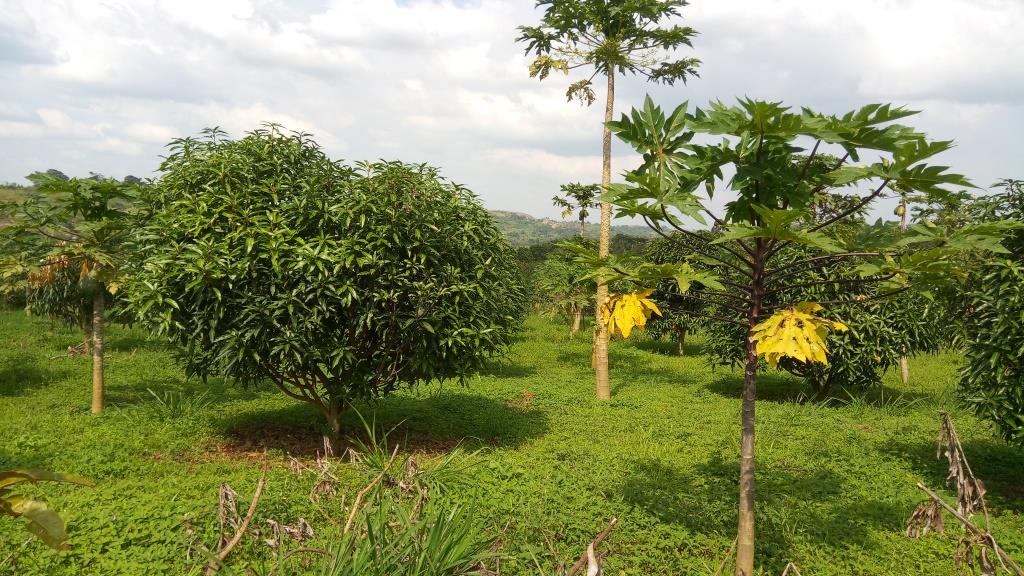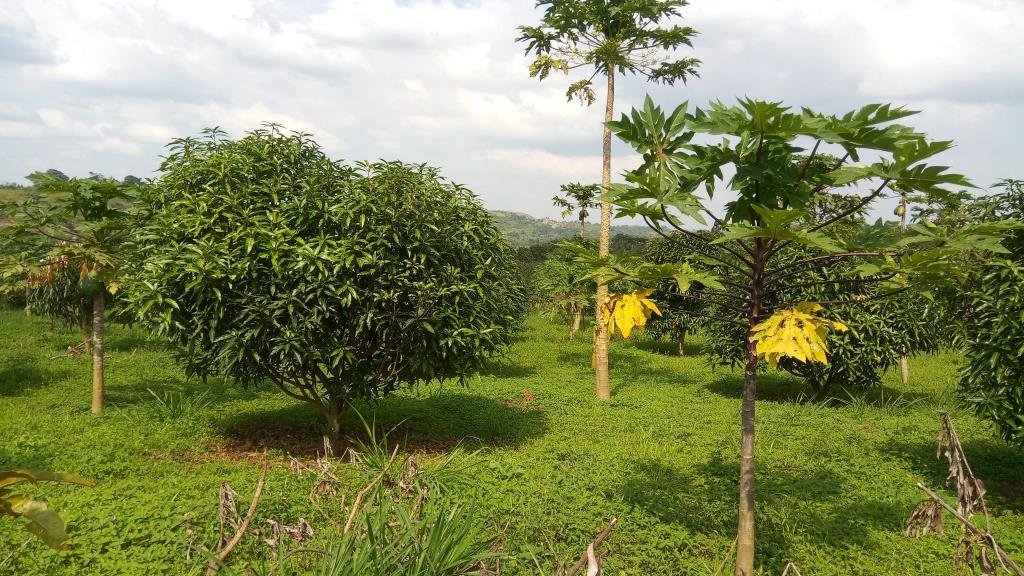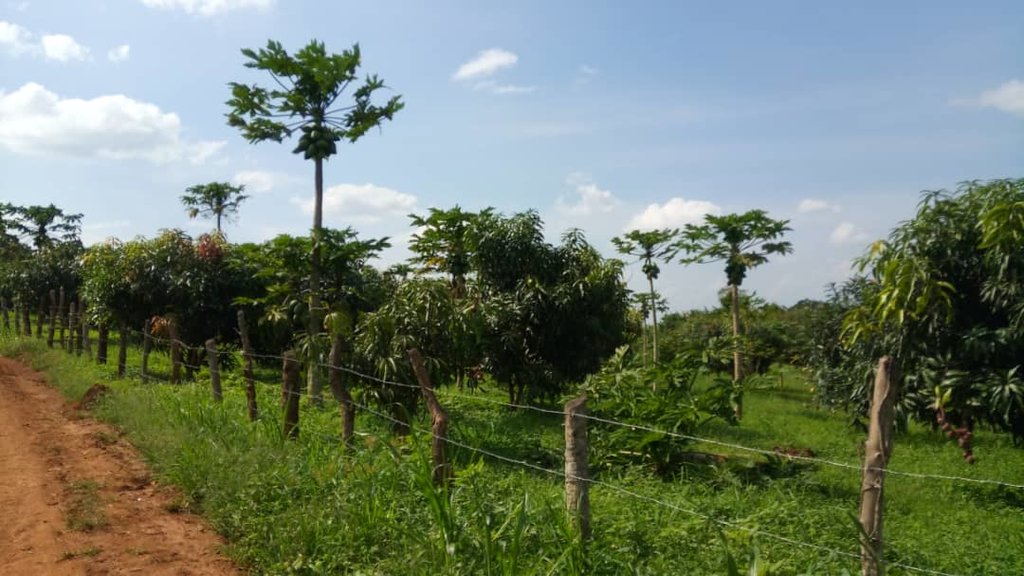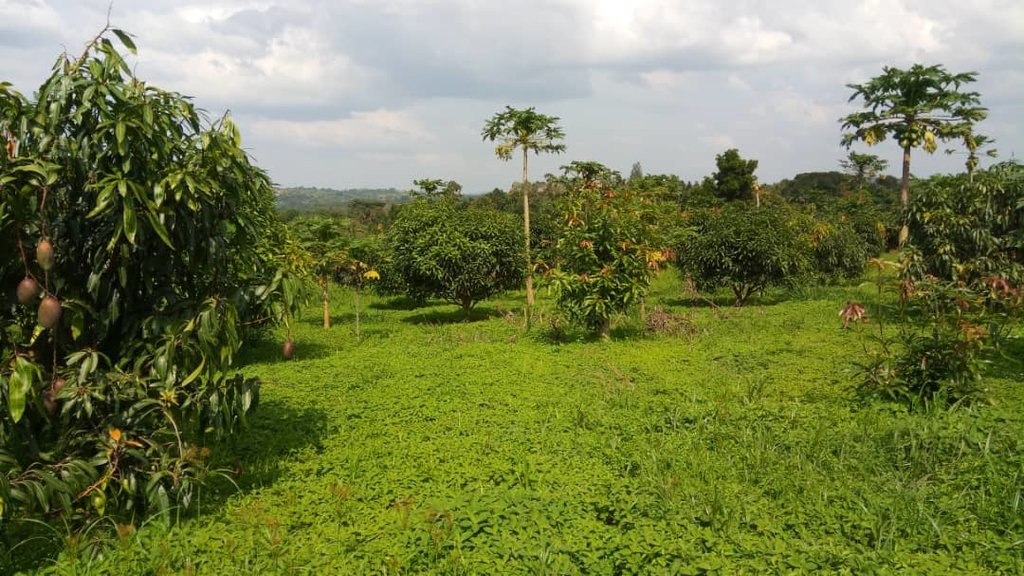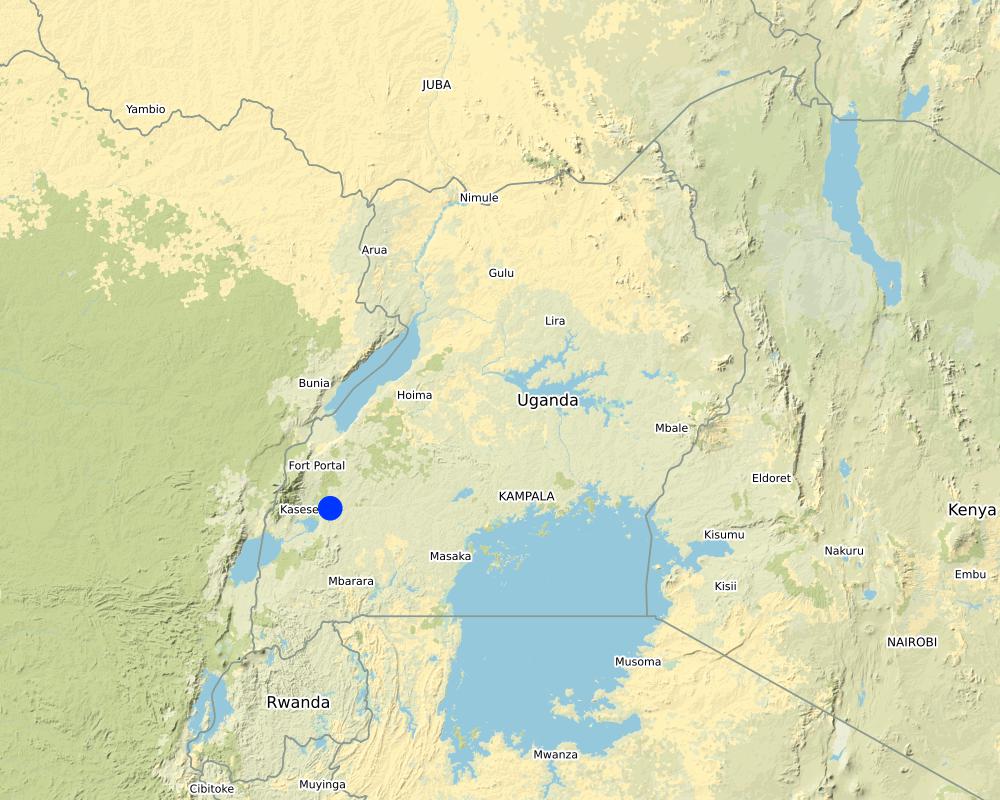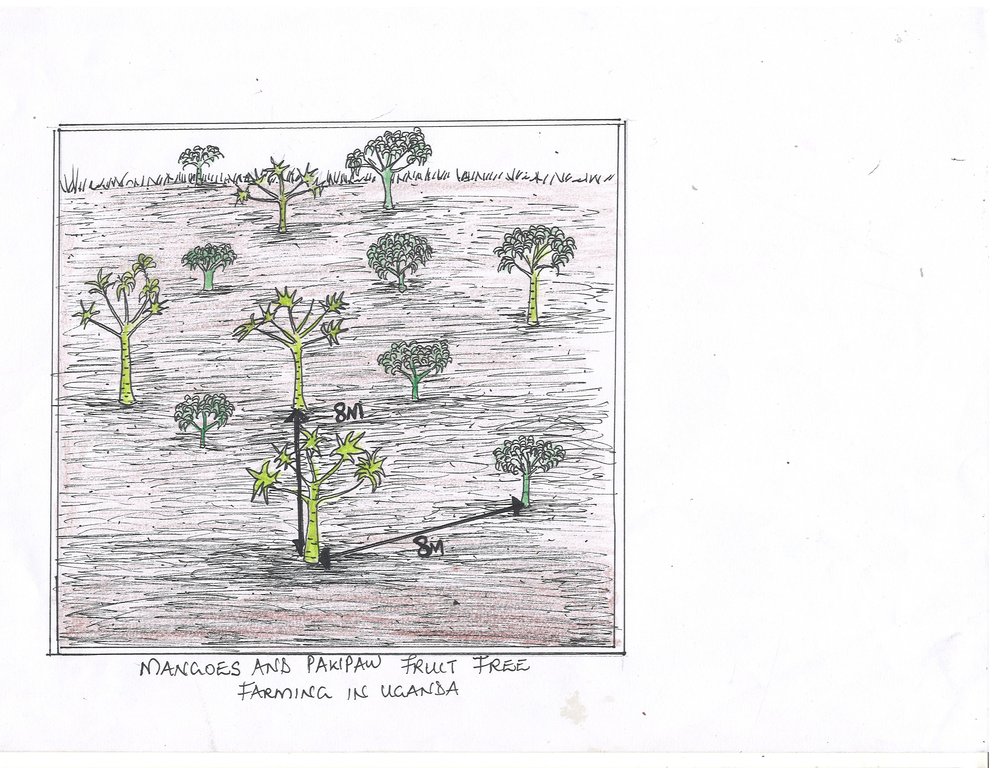Mango and paw-paw fruit tree growing [乌干达]
- 创建:
- 更新:
- 编制者: PRISCILLA VIVIAN KYOSABA
- 编辑者: Kamugisha Rick Nelson
- 审查者: Nicole Harari, Udo Höggel
Okuliima emiyembe ahamwe namapapali
technologies_3302 - 乌干达
查看章节
全部展开 全部收起1. 一般信息
1.2 参与该技术评估和文件编制的资源人员和机构的联系方式
关键资源人
土地使用者:
Yusufu Rev Tinkasimire
KYEGEGWA TOWN COUNCIL
乌干达
有助于对技术进行记录/评估的项目名称(如相关)
Scaling-up SLM practices by smallholder farmers (IFAD)有助于对技术进行记录/评估的机构名称(如相关)
National Agricultural Research Organisation (NARO) - 乌干达1.3 关于使用通过WOCAT记录的数据的条件
(现场)数据是什么时候汇编的?:
14/11/2017
编制者和关键资源人员接受有关使用通过WOCAT记录数据的条件。:
是
1.4 所述技术的可持续性声明
这里所描述的技术在土地退化方面是否存在问题,导致无法被认为是一种可持续的土地管理技术?:
否
2. SLM技术的说明
2.1 技术简介
技术定义:
Fruit growing is one of the important and high paying branches of horticulture that involves planting of improved mango (mangifera indica) and paw paw (carica papaya)varieties in rows, with pawpaws(carica papaya) planted in between the mango(mangifera) trees with the aim of obtaining fruits for sale for income and environmental conservation.
2.2 技术的详细说明
说明:
Mangoes (mangifera indica) integrated with pawpaw (carica papaya) on farm is a sustainable land management practice promoted by farmers in Kyeggwa District with the aim of producing for commercial purposes and soil fertility improvement. It is normally established on a one acre piece of land individually owned by the farmer. The varieties grown are mainly high breed grafted tree in nature that were supplied to the farmer by the area local government project aimed at scaling up fruit farming and eradication of poverty among the farming community.
The fruit tree farm is normally established on a gentle sloping area. In this area, due to over-cultivation, the soils where previously exposed to both wind and water erosion and degradation by heavy sunshine especially during the dry season. To address this, the farmer allowed weeds to grow under the trees which he slashed and left them to work as mulch material that protected the soils from erosion, moisture loss and fertility boost. Establishment of the plantation started with designation and enclosure of the area with a barbed wire to protect the establishments from free grazing goats and cattle, playing children and thieves. This was followed by clearing of shrubs and grasses, making of planting basins of dimensions 2×2 feet and application of manure a month prior to the planting of seedlings. The basin is made at a spacing of 8×8 meters from each other and on planting an alternating mango to pawpaw tree pattern is established in the garden. Shrub sticks are then used to build an enclosure around the fruit seedlings to further protect it from intruders that may pass through the barbed wire fence. Maintenance activities are quite laborious and recurrent, they include; daily irrigation of the seedlings in the dry season until they are a meter plus, spraying of insecticides and fungi on a weekly basis, pruning, harvesting and weeding. The activities are recurrent and require the farmer to employ two men to aid on the farm. The farmer faces challenges of snakes, rodents and birds that eat the fruits and therefore he needs to be always on alert when harvesting fruits.
Establishment costs per acre of the orchard is relatively expensive, one hundred sixty (160) mangoes and pawpaw tree seedlings valued at USD 123.2 where supplied to the farmer by local government for planting. The following activities were done to set up the technology:
- 4 men for the to fencing work,
- Clearing the land
- Preparing planting basins
- Planting the seedling which took them 5 days,
- Purchasing manure 20 sacks all those costed USD 304.3.
The maintenance activities, done at the farm include applying insecticides and fungicides on a weekly basis plus ring weeding.
The farm is maintained at average cost of USD 410.9 up to the fruiting stage, beyond which a well grown mango tree plant on harvest produces averagely between sixty (60) and eighty (80) mango fruits whereas for the pawpaw it produces between 20 and 30 respectively. This earns the farmer close to USD 1183 each harvest of the two seasons in the year which is significantly worth the farmer’s efforts.
2.3 技术照片
2.4 技术视频
注释、简短说明:
Mangoes (mangifera indica) and paw-paws (carica papaya) field.
日期:
14/11/2017
位置:
Kyegegwa District
2.5 已应用该技术的、本评估所涵盖的国家/地区/地点
国家:
乌干达
区域/州/省:
Western Region
有关地点的进一步说明:
Kyegegwa town
Map
×2.6 实施日期
注明实施年份:
2013
2.7 技术介绍
详细说明该技术是如何引入的:
- 通过项目/外部干预
注释(项目类型等):
The farmer owning this fruit tree farm acquired both the knowledge and fruit tree seedlings from District local gorvernment that was working in partnership with National Agriculture Advisory Services (NAADS)
3. SLM技术的分类
3.1 该技术的主要目的
- 创造有益的经济影响
- 创造有益的社会影响
3.2 应用该技术的当前土地利用类型

混合(作物/放牧/树木),包括农林
- Horticulture
3.3 有关土地利用的更多信息
该技术所应用土地的供水:
- 雨养
每年的生长季节数:
- 2
3.4 该技术所属的SLM组
- 最小的土壤扰动
- 改良植物品种/动物品种
3.5 技术传播
具体说明该技术的分布:
- 适用于特定场所/集中在较小区域
3.6 包含该技术的可持续土地管理措施

植物措施
- V1:乔木和灌木覆盖层
3.8 防止、减少或恢复土地退化
具体数量名该技术与土地退化有关的目标:
- 不适用
4. 技术规范、实施活动、投入和成本
4.1 该技术的技术图纸
4.2 技术规范/技术图纸说明
1 acre of fruit trees planted.
The field area is 80*50M
Spacing between the trees is 8*8 meters
Tree plant basin size is 2*2 feet.
The fruit farm is on a gentle slope
4.3 有关投入和成本计算的一般信息
具体说明成本和投入是如何计算的:
- 每个技术单元
指定单位:
1 acre
具体说明成本计算所用货币:
- 美元
注明美元与当地货币的汇率(如相关):1美元=:
3650.0
注明雇用劳工的每日平均工资成本:
42900
4.4 技术建立活动
| 活动 | 措施类型 | 时间 | |
|---|---|---|---|
| 1. | Clearing the land | 管理 | Once |
| 2. | Digging plant basins | 其它措施 | Once |
| 3. | Apply manure in the established plant basins | 其它措施 | Once |
| 4. | Plant the seedlings | 管理 | Once |
4.5 技术建立所需要的费用和投入
| 对投入进行具体说明 | 单位 | 数量 | 单位成本 | 每项投入的总成本 | 土地使用者承担的成本% | |
|---|---|---|---|---|---|---|
| 劳动力 | Clearing the land | Man acre | 5.0 | 60000.0 | 300000.0 | 100.0 |
| 劳动力 | Digging plant basins and planting | Man acre | 5.0 | 90000.0 | 450000.0 | 100.0 |
| 植物材料 | Fruit tree seedlings | Seedlings | 160.0 | 2000.0 | 320000.0 | |
| 肥料和杀菌剂 | Organic manure application | Sacks | 20.0 | 18000.0 | 360000.0 | 100.0 |
| 技术建立所需总成本 | 1430000.0 | |||||
4.6 维护/经常性活动
| 活动 | 措施类型 | 时间/频率 | |
|---|---|---|---|
| 1. | Weeding | 管理 | Monthly |
| 2. | Spraying | 管理 | After two weeks |
| 3. | Prunning | 管理 | After three months |
| 4. | Fertilizer and manure application | 管理 | Monthly |
4.7 维护/经常性活动所需要的费用和投入(每年)
如果可能,按下表分解技术维护费用,并列明各项投入和每项投入的费用。如果您无法分解成本,给出维护该技术的总成本估算。:
530000.0
如果土地使用者负担的费用少于100%,请注明由谁负担其余费用:
A public organisation known as National Agriculture Advisory Services (NAADS) provided the farmer with fruit tree seedlings
注释:
Maintenance activities cost estimated on a yearly basis
4.8 影响成本的最重要因素
描述影响成本的最决定性因素:
The equipment's and materials needed for establishment plus maintenance are relatively expensive
5. 自然和人文环境
5.1 气候
年降雨量
- < 250毫米
- 251-500毫米
- 501-750毫米
- 751-1,000毫米
- 1,001-1,500毫米
- 1,501-2,000毫米
- 2,001-3,000毫米
- 3,001-4,000毫米
- > 4,000毫米
农业气候带
- 半湿润
5.2 地形
平均坡度:
- 水平(0-2%)
- 缓降(3-5%)
- 平缓(6-10%)
- 滚坡(11-15%)
- 崎岖(16-30%)
- 陡峭(31-60%)
- 非常陡峭(>60%)
地形:
- 高原/平原
- 山脊
- 山坡
- 山地斜坡
- 麓坡
- 谷底
垂直分布带:
- 0-100 m a.s.l.
- 101-500 m a.s.l.
- 501-1,000 m a.s.l.
- 1,001-1,500 m a.s.l.
- 1,501-2,000 m a.s.l.
- 2,001-2,500 m a.s.l.
- 2,501-3,000 m a.s.l.
- 3,001-4,000 m a.s.l.
- > 4,000 m a.s.l.
5.3 土壤
平均土层深度:
- 非常浅(0-20厘米)
- 浅(21-50厘米)
- 中等深度(51-80厘米)
- 深(81-120厘米)
- 非常深(> 120厘米)
土壤质地(表土):
- 中粒(壤土、粉土)
土壤质地(地表以下> 20厘米):
- 中粒(壤土、粉土)
表土有机质:
- 中(1-3%)
5.4 水资源可用性和质量
地下水位表:
< 5米
地表水的可用性:
中等
水质(未处理):
良好饮用水
水的盐度有问题吗?:
否
该区域正在发生洪水吗?:
否
5.5 生物多样性
物种多样性:
- 中等
栖息地多样性:
- 中等
5.6 应用该技术的土地使用者的特征
生产系统的市场定位:
- 混合(生计/商业
非农收入:
- 低于全部收入的10%
相对财富水平:
- 平均水平
个人或集体:
- 个人/家庭
机械化水平:
- 手工作业
土地使用者的年龄:
- 老年人
5.7 应用该技术的土地使用者拥有或租用的平均土地面积
- < 0.5 公顷
- 0.5-1 公顷
- 1-2 公顷
- 2-5公顷
- 5-15公顷
- 15-50公顷
- 50-100公顷
- 100-500公顷
- 500-1,000公顷
- 1,000-10,000公顷
- > 10,000公顷
这被认为是小规模、中规模还是大规模的(参照当地实际情况)?:
- 小规模的
5.8 土地所有权、土地使用权和水使用权
土地所有权:
- 个人,未命名
土地使用权:
- 个人
用水权:
- 个人
5.9 进入服务和基础设施的通道
健康:
- 贫瘠
- 适度的
- 好
教育:
- 贫瘠
- 适度的
- 好
技术援助:
- 贫瘠
- 适度的
- 好
就业(例如非农):
- 贫瘠
- 适度的
- 好
市场:
- 贫瘠
- 适度的
- 好
能源:
- 贫瘠
- 适度的
- 好
道路和交通:
- 贫瘠
- 适度的
- 好
饮用水和卫生设施:
- 贫瘠
- 适度的
- 好
金融服务:
- 贫瘠
- 适度的
- 好
6. 影响和结论性说明
6.1 该技术的现场影响
社会经济效应
收入和成本
农业收入
注释/具体说明:
With this practice the farmer reported getting income of 6 millions from the two harvest seasons in a year which is high compared to the 2 million he uses to raise from growing beans and maize annually
社会文化影响
食品安全/自给自足
注释/具体说明:
Farmer earns income from selling fruits from his garden. Therefore he does not sell his crop produce, saves it for food.
健康状况
注释/具体说明:
Farmer says he harvest and consumes a fruit on daily basis hence improving his and family's health status.
生态影响
减少气候和灾害风险
干旱影响
注释/具体说明:
Underneath the trees is a permanent soil cover which maintains soil moisture enabling trees to resist drought.
6.2 该技术的场外影响已经显现
下游淤积
6.3 技术对渐变气候以及与气候相关的极端情况/灾害的暴露和敏感性(土地使用者认为的极端情况/灾害)
渐变气候
渐变气候
| 季节 | 气候变化/极端天气的类型 | 该技术是如何应对的? | |
|---|---|---|---|
| 年温度 | 减少 | 适度 | |
| 季节性温度 | 湿季/雨季 | 减少 | 适度 |
| 年降雨量 | 增加 | 适度 | |
| 季雨量 | 湿季/雨季 | 增加 | 适度 |
气候有关的极端情况(灾害)
气象灾害
| 该技术是如何应对的? | |
|---|---|
| 局地雹灾 | 非常好 |
气候灾害
| 该技术是如何应对的? | |
|---|---|
| 干旱 | 好 |
生物灾害
| 该技术是如何应对的? | |
|---|---|
| 昆虫/蠕虫侵扰 | 适度 |
注释:
Beneath the trees is a permanent cover of grass which enhances soil moisture retention enabling the trees to survive drought. The trees have a huge canopy which acts as a soil cover improving soil moisture retention.
6.4 成本效益分析
技术收益与技术建立成本相比如何(从土地使用者的角度看)?
短期回报:
消极
长期回报:
稍微积极
技术收益与技术维护成本/经常性成本相比如何(从土地使用者的角度看)?
短期回报:
稍微积极
长期回报:
积极
6.5 技术采用
- 1-10%
在所有采用这项技术的人当中,有多少人是自发地采用该技术,即未获得任何物质奖励/付款?:
- 0-10%
6.6 适应
最近是否对该技术进行了修改以适应不断变化的条件?:
否
6.7 该技术的优点/长处/机会
| 土地使用者眼中的长处/优势/机会 |
|---|
| Serves as an employment opportunity for this farmer |
| Provide Income after sell of fruits to invest in sustainable land management practices |
| Can easily be replicated in other areas |
| 编制者或其他关键资源人员认为的长处/优势/机会 |
|---|
| Provide a large yield of fruit year after year for decades, requiring little human input when compared to the growing, planting, weeding, watering, pest control involved in annual vegetables. As a deep-rooted, long-lived perennial, the tree has time to adapt to local conditions and be more resilient. |
| Fruit tree orchards provide vital green spaces in our cities and towns, where people are encouraged to interact with nature either through becoming custodians of the trees or by simply being around them and enjoying their shade, beauty and fruit. |
6.8 技术的弱点/缺点/风险及其克服方法
| 土地使用者认为的弱点/缺点/风险 | 如何克服它们? |
|---|---|
| Relatively expensive to establish | Getting an organisation that can provide necessary equipment |
| Relatively expensive inputs for maintenance | District production office taking initiative to provide maintenance inputs like spraying pesticides at an affordable price |
| Ready fruits are bought cheaply sometime | Having an association for fruit growers that way fair prices can be set that favors all the farmers |
| 编制者或其他关键资源人员认为的弱点/缺点/风险 | 如何克服它们? |
|---|---|
| Relatively expensive to maintain; requires much capital to buy seedlings and pesticides | Access credit and pay after harvest |
| Much labor force required for establishment and maintaining | Form fruit growing groups and use group labour |
| It is very harmful to the environment – Intensive fruit farming usually involves the use of highly concentrated liquid fertilizers and a lot of deadly chemicals. These often find their way into the surrounding environment through rainwater runoff, where they wreak havoc on sensitive plants and animals | Promote use of organic fertiliser which is cheap and locally obtained |
7. 参考和链接
7.1 信息的方法/来源
- 与土地使用者的访谈
1
7.2 参考可用出版物
标题、作者、年份、ISBN:
Li, Zongyu, "Perception of Risk and Risk Management in Fruit and Vegetable Marketing in Tennessee: The Case of Product Liability Risk. " Master's Thesis, University of Tennessee, 2014
可以从哪里获得?成本如何?
Research Gate
7.3 链接到网络上可用的相关信息
标题/说明:
Benefits of orchards and fruit growing
URL:
https://www.theorchardproject.org.uk/guides_and_advice/benefits-of-orchards-and-fruit-growing/
标题/说明:
Production risks
URL:
https://www.researchgate.net/figure/Production-risks-in-farming-of-fruits-and-vegetables_tbl5_227365161
标题/说明:
Risk Management
URL:
Agricultural, Food and the Environment
链接和模块
全部展开 全部收起链接
无链接
模块
无模块


